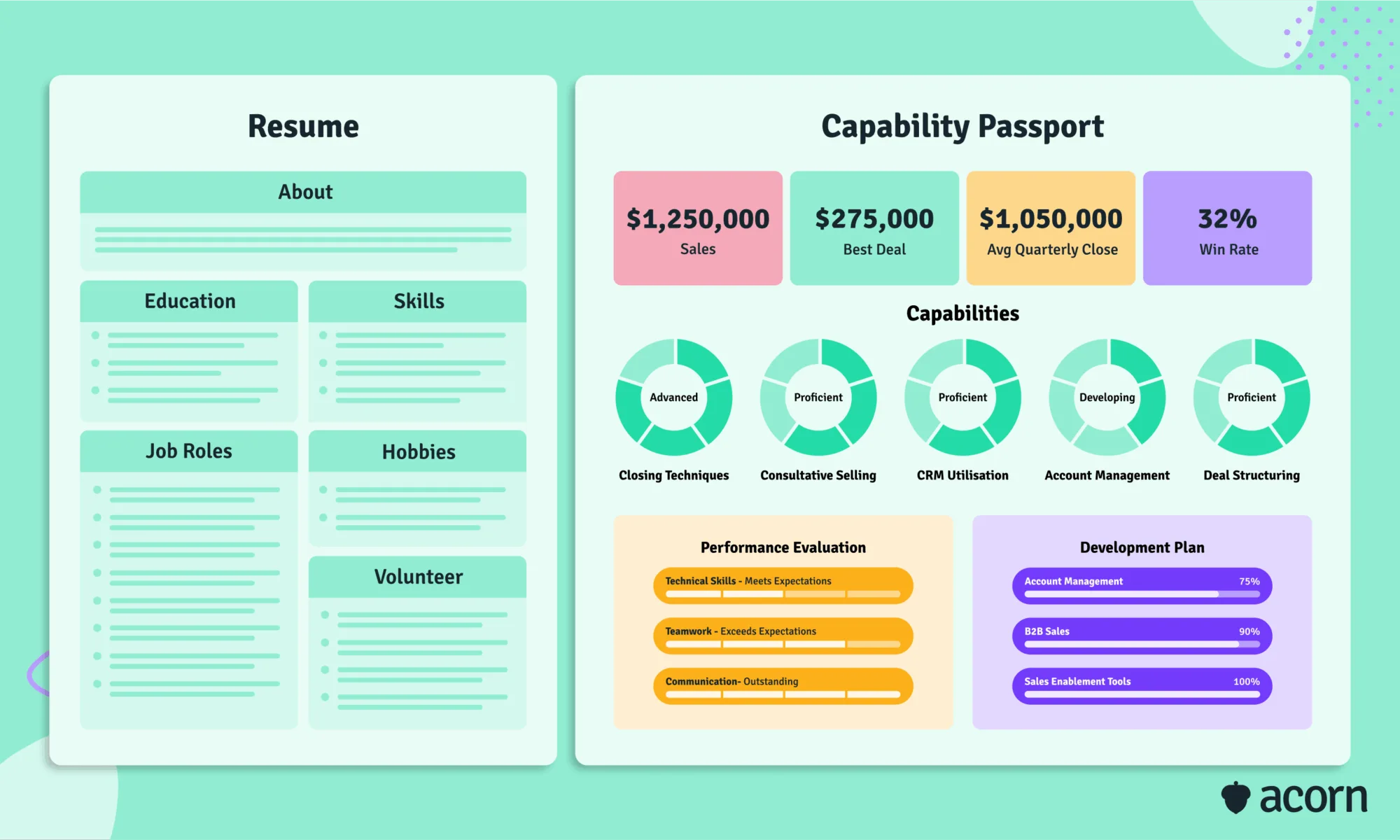Skills Are Out, Capability Passports Are About to Be In
Reading Time:

Lead the pack with the latest in strategic L&D every month— straight to your inbox.
SubscribeWorkforce disruption isn’t coming soon. It’s already here.
Globally, there’s an unprecedented demand for new capabilities as people move across jobs and entire industries shift.
That raises a couple of big questions: How do we make talent visible, portable, and relevant, no matter where work takes people? How do we make the talent playing field level for all?
While still in early development, there’s an answer emerging in a few corners of the world. The capability passport is about to enter the chat.
The journey to enable real talent mobility
Many countries have recognized the need for centralized records of people’s capabilities outside their current organization. Australia is piloting a National Skills Passport to make qualifications easier to share across employers. Singapore has MySkillsFuture.
Scotland is trialling an Energy Skills Passport to help oil and gas workers transition into renewable energy. The keyword is transition because the goal is to ensure these workers know what further qualifications they need to work in new careers. It’s a mutually beneficial initiative, since it should help support a pipeline of workers needed to deliver on the Scottish Government’s goal of clean power by 2030.
These programs are an important step toward transparency and mobility. They show that employees increasingly expect clear evidence of what they’ve learned and how it applies to future roles.
Thing is, skills passports are mainly housed within the public sector, where interagency talent pools already exist.
Capability passports build on this momentum by widening the focus. Other tools would document just formal credentials or certifications or need a shared talent database. Capability passports create a broader, more dynamic picture of what someone can do—including:
- Practical skills and experience gained on the job
- The behaviors and new ways of working developed
- The knowledge, tools, and processes that drive performance within an organization
- Business impact affected by the above.
In short, where skills passports often answer “What have you learned?”, capability passports also cover “How do you apply what you’ve learned—and how ready are you to grow?”
This shift makes capability passports valuable for organizations that want to give their people autonomy over their careers while aligning development with business strategy.
What is a capability passport?
A capability passport is an enduring record of the capabilities a person has amassed throughout their working life. Rather than an itemized list of qualifications or past roles, a passport provides tangible evidence of what someone can do.
The other major differentiator between a capability passport and skills passports or resumes is where it lives: in your existing learning and performance tech. And while resumes or skills profiles may rely on the individual to be updated, a capability passport would be dynamic and autonomously updated through regular assessments, validated achievements, and learning milestones. Oh, and already tailored to how an organization talks about and assesses performance.
Why do we need capability passports?
Solid bet we’ve all hired someone who looked great on paper but struggled in practice. The solution seems to be arduous recruitment processes, involving time-consuming tasks for candidates to prove their expertise. Which, for unsuccessful candidates, amounts to doing a lot of work for free.
On the flip side, resumes don’t always capture the nuance of someone’s career trajectory. For the hiring manager, that means little knowledge of what gaps the incoming employee has or the training they might need.
Because a passport is tied to your capability framework and learning content, it shows current proof of proficiency through:
- The capabilities demonstrated in every role
- The training completed
- The outcomes delivered.
And not just that, but also shows the time taken to develop those capabilities, complete that training, and hit those outcomes, thanks to historic capability assessments.

That level of clarity works both ways. For employees and candidates, it makes strengths and development areas visible without relying on memory or having to request training history from past employers. For organizations, it means less guesswork and faster, more confident hiring decisions.
This matters now more than ever. Labor markets are evolving constantly while industries are converging, new capabilities emerging, and people changing careers entirely. On top of that, 89% of managers admit people have to leave to get career advancement.
When you consider that bad hires can cost up to 30% of their first-year salary, and 20% of new employees quit within 45 days due to a lack of clarity, the business case for capability passports becomes pretty clear.
So, all things considered, there are three distinct ways capability passports are needed to level the talent playing field.
- They make internal mobility real.
The traditional path to career growth is a promotion. But this can frustrate high-performing ICs who don’t want to manage people. It also narrows the talent pool available for employers. Capability passports help people see lateral paths and give leaders evidence to support moves that fit both the person and the business.
- Hiring decisions improve.
Instead of relying on resumes or gut feeling (hello, bias), you get a living record of proven impact. That means more objective, faster, and fairer selection, and…
- Productivity is accelerated—and captured.
When new hires onboard, you already know what they’re great at and what support they need. Training can be targeted (and replicated), onboarding streamlined, and time to impact reduced.
How do capability passports work in practice?
At Acorn, we believe the next generation of capability passports won’t just document what people have done. They’ll actively guide where they can go next.
Imagine this:
- A platform that maps every capability across your workforce
- A real-time view of gaps, strengths, and opportunities
- Learning recommendations tied directly to business priorities
- A single source of truth that evolves with your people.
That offers people a personalized roadmap, helping them to prepare for future roles by identifying the roles they could step into and essentially giving them the instructions on what to do to get there.
And for organizations? You start to build a self-sufficient workforce development program fueled by a real culture of learning. Oh, and you build deeper pools of talent by giving people and managers the resources to identify potential and opportunities. In turn, you get better decision-making in recruitment, internal mobility, and training investments.
Moreover, by living within your existing performance and learning systems, capability passports reduce administrative burdens and ensure that data remains current, actionable, and directly related to business strategy. Win-win.
Key takeaways
Good talent is often hidden in the mess of HR systems, tools, and documents. The capability passport will make it easier for organizations to find, develop, and retain talent faster and in the right roles.
Resumes won’t get you there. Static skills records won’t either. Only a living, breathing capability passport can connect talent to business strategy at scale and across companies.
But even better, they give individuals ownership of their career and the steps they’ve taken to get where they are by making clear:
- Not just proof of proficiency, but the time taken to get up to speed
- The exact development pathways undertaken
- Auxiliary capabilities developed over their careers
- Evidence of their impact, through projects, business results, and peer feedback.
And in a market where skills, knowledge, and behaviors need to be more transferable than ever, the capability passport could just be the secret weapon.